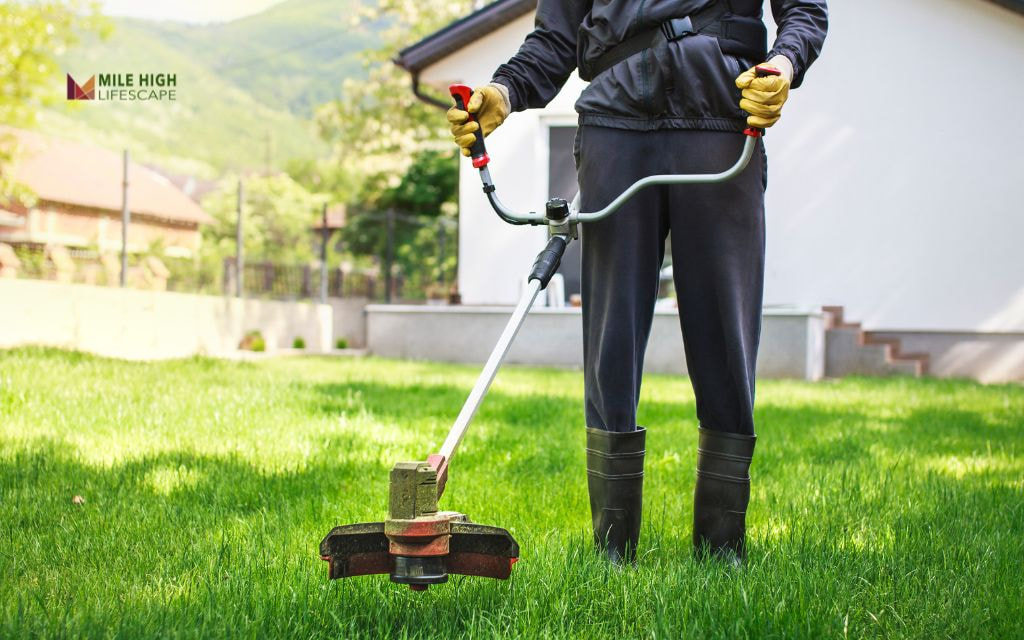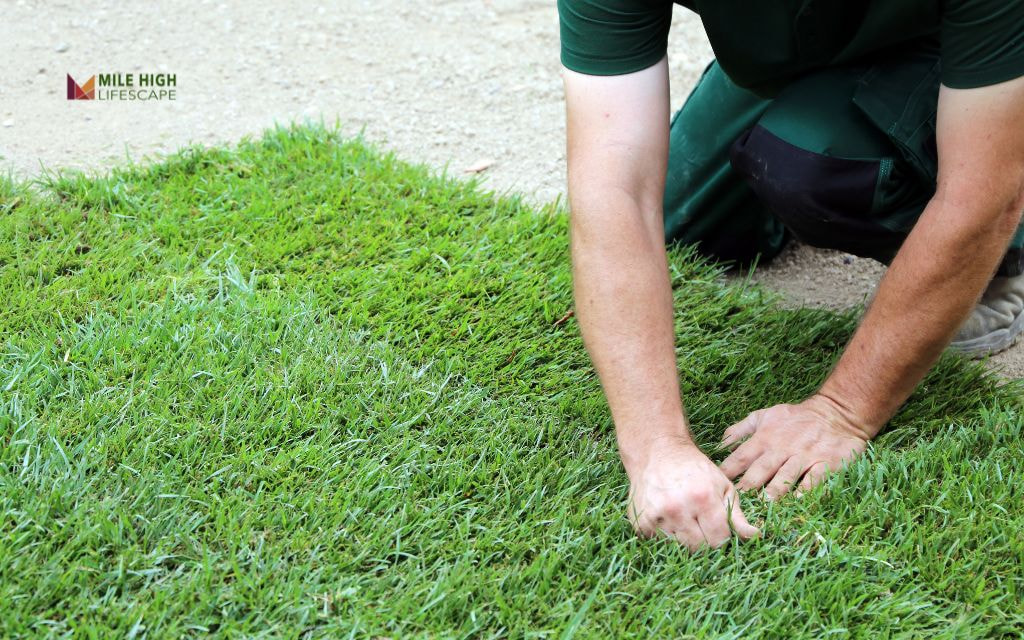New lawns require patience before the first mow. Wait until your grass reaches 3.5-4 inches tall – typically 3-4 weeks for seed and 10-14 days for sod in Denver’s climate.
This timing allows proper root establishment before introducing the stress of mowing. Each lawn type (seed, sod, or hydroseed) has specific requirements that determine when your grass is truly ready for its first cut.
Proper timing of your first mow determines the long-term health of your lawn. Cut too early, and you risk destroying weeks of careful cultivation and investment.
This guide outlines exactly when should you mow new lawn based on your lawn type – whether you’ve installed seed, sod, or hydroseed – along with techniques to ensure your new turf thrives through its first cut and beyond.
When Should You Mow New Lawn Grown from Seed?
For seeded lawns, patience delivers results. Wait until your grass consistently reaches 3.5-4 inches in height before considering that first mow.
Grass Type Considerations
Different grass varieties establish at different rates, affecting your first mow timeline:
- Kentucky bluegrass, popular in Denver, typically takes longer (approximately 5-6 weeks) to establish before mowing
- Tall fescue establishes quicker (around 4-5 weeks) before reaching proper mowing height
- Perennial ryegrass shows the fastest establishment (often 3-4 weeks) but still requires proper height before cutting
Check Soil Conditions
Before mowing, verify that soil moisture supports your equipment. The ground should feel firm underfoot, not spongy or muddy. Attempting to mow on saturated soil compacts the ground and damages tender roots.
In Denver’s climate, it’s best to time your mowing 2-3 days after irrigation or rainfall, when soil has proper moisture without excess saturation. Morning dew should completely dry before mowing begins.
Testing Lawn Readiness
Beyond height, test your lawn’s readiness with these simple methods:
- Walk test: Walk across the lawn in several directions – your footprints should spring back quickly without leaving permanent depressions
- Pull test: Gently tug on grass blades – they should resist rather than pull free easily
- Uniformity check: Ensure at least 90% of the lawn has reached proper height – don’t mow based on the fastest-growing patches
Preparing for the First Cut
The day before your planned first mow, prepare both your lawn and equipment:
- Water lightly 24-48 hours beforehand to ensure proper soil moisture without saturation
- Inspect the lawn for debris, stones, or obstacles that could damage your mower
- Set your mower height to remove only the top 1/3 of grass height (typically 2.5-3 inches for the first cut)
- Ensure blades are perfectly sharp to cut rather than tear new grass

When Should You Mow New Lawn from Sod in Denver’s Climate
New sod requires 10-14 days to establish root connections with the soil beneath. During this period, the grass develops the stability needed to withstand mowing stress. Rushing this process risks damaging or dislodging entire sections of your investment.
Signs Your Sod Is Ready for Mowing
Your sod is ready for its first mow when you observe these indicators:
- Grass blades stand firmly upright after light foot traffic
- Walking on the lawn feels stable without sinking sensation
- Gentle tugging on grass blades meets resistance from established roots
- Sod pieces no longer lift easily at the edges
- No visible gaps remain between sod sections
First Mow Height Guidelines
For the initial cut, maintain a height of 3-3.5 inches using lightweight equipment. This preserves both blade health and developing root systems while removing just enough growth to encourage thickening. Never remove more than 1/3 of the blade length during this crucial first mowing session.
Mowing Technique for New Sod
Take special care during the first mow:
- Use a sharp, well-maintained mower to ensure clean cuts
- Mow in straight lines without sharp turns that can stress sod edges
- Overlap each pass slightly to prevent missed strips
- Consider bagging clippings for the first mow to reduce debris on developing turf
Mowing After Hydroseeding: What’s Different?
Hydroseeded lawns create an interesting challenge: they typically produce rapid top growth while roots develop more slowly. This disparity requires careful timing for the first mow.
Timing Your First Cut
Wait 3-4 weeks minimum after hydroseeding, ensuring grass height reaches 3.5-4 inches consistently across the lawn. This timing allows root systems to establish sufficiently to withstand mowing stress.
Denver’s climate can extend this timeline – dry periods may slow development while occasional spring rains can accelerate growth. Trust height measurements over calendar dates.
Watch for Problem Areas
Pay particular attention to soil conditions with hydroseeded lawns. Areas with compacted soil or pooled water indicate the lawn isn’t ready, regardless of blade height.
These conditions suggest root systems haven’t developed properly and need more time before mowing. Test readiness by gently tugging a few grass blades – significant resistance indicates developing root strength.

Special Considerations
The mulch component in hydroseed mixtures creates unique conditions during establishment. This protective layer retains moisture but can sometimes form a crust that needs monitoring. Ensure this layer has properly integrated with the soil before mowing.
Additionally, hydroseed applications on slopes may develop at different rates – lower areas often grow faster due to moisture collection, requiring evaluation of the entire lawn rather than just the fastest-growing sections.
Pay particular attention to soil conditions with hydroseeded lawns. Areas with compacted soil or pooled water indicate the lawn isn’t ready, regardless of blade height. These conditions suggest root systems haven’t developed properly and need more time before mowing.
Why the First Mow Matters So Much
Understanding the biology explains the importance: young grass operates with shallow, developing root systems and softer blade structures than established lawns. The stress of cutting removes stored energy from blades while roots are still establishing their nutrient uptake capabilities.
Premature mowing forces the plant to redirect resources toward blade repair rather than root development. This compromises the foundation of your lawn, leading to weakened drought tolerance and vulnerability to Colorado’s summer heat.
Denver’s specific environmental factors compound these risks. Our dry winds accelerate moisture loss from freshly cut blades, while spring temperature fluctuations can shock newly cut grass if cold fronts follow mowing.
Common problems from early mowing:
- Uprooting fragile seedlings due to insufficient root anchorage
- Grass blade tearing instead of clean cutting, creating entry points for disease
- Fungal development risk from dense clippings that smother new growth
- Reduced drought tolerance when summer heat arrives

Mowing Equipment & Technique for the First Cut
Select appropriate equipment for your lawn’s developmental stage. Reel mowers or lightweight rotary push mowers distribute minimal pressure across the turf surface. Avoid heavy riding mowers during the first several cuts as they compress soil and risk tearing young grass.
Blade sharpness determines cutting quality. Dull mower blades tear grass rather than cutting cleanly, leaving jagged edges that lose moisture rapidly and create entry points for disease. Sharpen or replace blades before mowing new lawns.
Execute the first mow with deliberate care: move slowly in straight lines, only when turf is completely dry, and cut with precision rather than speed. This methodical approach minimizes stress on developing grass.
First mow best practices:
- Sharpen blades before mowing to ensure clean cuts
- Set mower deck to 3+ inches to preserve adequate leaf surface
- Avoid mowing when grass is wet to prevent clumping and disease
- Alternate mowing directions weekly to prevent compaction patterns
- Use mulch setting only if clippings are light and distribute evenly
What Are The Next Steps After the First Mow?
Water Gently Post-Mow
Apply light irrigation the morning following your first mow. This helps grass recover from cutting stress without creating soggy conditions. Aim for moisture without saturation, typically 1/4 inch of water.
Avoid Overfeeding Young Lawns
Only apply starter fertilizer after first mowing if you didn’t incorporate it during planting. Excessive fertilization forces top growth at the expense of root development. Follow product guidelines for new lawn applications, typically using half the recommended rate.
Skip the Weed Killers for Now
Delay herbicide applications until after the lawn has established and endured 2-3 successful mowings. Young grass remains highly sensitive to chemical treatments, and premature application risks damaging or killing your new lawn.
Mistakes to Avoid with New Lawn Mowing
- Mowing wet grass: Creates clumping, spreads potential diseases, and compacts soil beneath tender root systems.
- Cutting too short: Removes excessive leaf surface needed for photosynthesis, shocking developing grass and limiting energy production.
- Using heavy mowers too early: Compresses soil and creates ruts while risking physical damage to grass that hasn’t anchored securely.
- Bagging all clippings: Removes potential nutrient cycling benefits when clippings are light enough to decompose quickly between blades.
- Skipping blade maintenance: Creates ragged cuts that lose moisture rapidly and develop brown tips, giving new lawns a stressed appearance.

Should You DIY or Hire a Pro for the First Mow?
Handling the first mow yourself is certainly possible with proper equipment and care. Success requires a sharp, properly adjusted mower, careful attention to lawn readiness signals, and commitment to proper technique.
However, professional services offer significant advantages for this critical first cut. Mile High Lifescape’s lawn care specialists understand Denver’s specific grass varieties and growth patterns, reducing risk during this vulnerable period.
Our expertise proves particularly valuable for high-investment lawns where mistakes carry greater consequences.
When to Call in the Pros?
- You lack access to a properly maintained, sharp mower
- Lawn still demonstrates uneven growth or spongy texture
- You’re uncertain about optimal watering and fertilizing schedules
- Your lawn represents significant investment as part of comprehensive landscaping
Conclusion
Timing and technique during your first mow establish the foundation for years of lawn health. The patience required during establishment pays dividends through stronger root development, improved drought tolerance, and more robust resistance to Colorado’s challenging conditions.
Resist the urge to rush this critical step. Whether you’ve installed seed, sod, or hydroseeded your lawn, allowing proper establishment before mowing creates resilience that serves your landscape throughout its lifecycle.
For personalized guidance on your specific lawn type and growth stage, contact Mile High Lifescape. Our Denver lawn mowing service offers seasonal care strategies tailored to your property’s unique conditions and grass varieties.
Frequently Asked Questions (FAQs)
Can I mow my new lawn after one week?
Only if you’ve installed sod and it shows clear rooting evidence. Never mow seed or hydroseeded lawns this early, as their root systems remain undeveloped.
How tall should new grass be before you mow it?
3.5-4 inches tall for all establishment methods (seed, sod, hydroseed). This height ensures adequate root development before cutting stress.
Should I water before or after the first mow?
Water lightly the day before mowing to ensure soil firmness without wetness. After mowing, apply gentle irrigation the following morning to aid recovery.
What’s the best mower type for new lawns?
A lightweight push mower with freshly sharpened blades provides optimal results. Avoid heavy riding mowers until the lawn fully establishes.
How long should you wait to mow a new lawn?
For seeded lawns, typically 3-6 weeks in Denver; for sod, 10-14 days; for hydroseeded lawns, 3-4 weeks minimum. Always prioritize grass height and root establishment over calendar timing.
Does cutting grass help new grass grow?
Yes, but only after proper establishment. The first mow stimulates lateral growth and thickening, but only when roots have developed sufficiently to support this transition.
What happens if you mow over new grass seed?
Mowing too early after seeding dislodges developing seedlings, destroys tender growth, and creates bare patches that require reseeding. Wait until grass reaches 3.5-4 inches tall before cutting.
